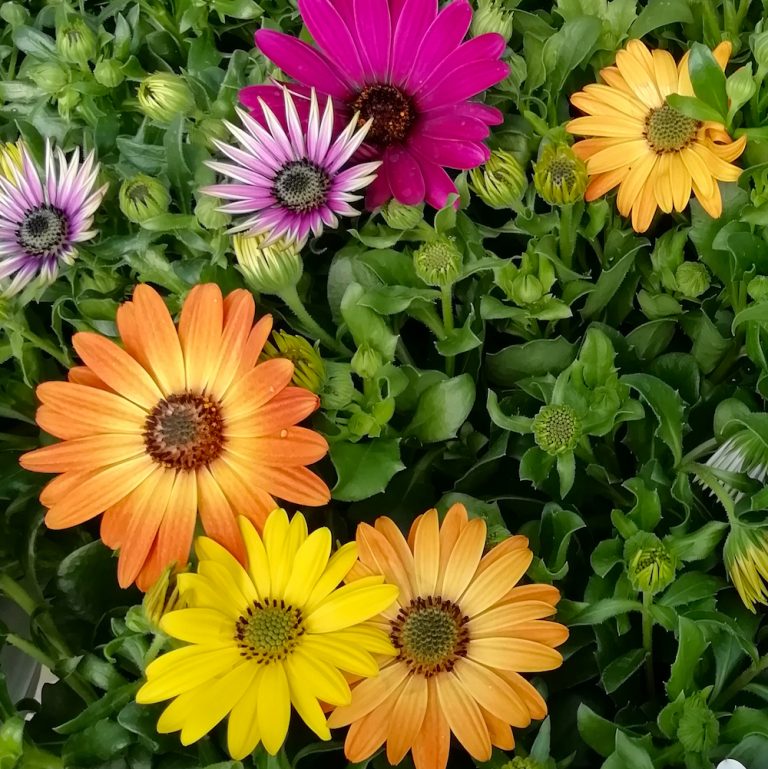How To Grow And Care For A Osteospermum Plant
Have you ever heard of the Osteospermum? It may sound like a dinosaur, but it's actually a beautiful plant commonly known as the Cape Daisy. This plant may not be as popular as roses or sunflowers, but it sure does pack a punch in terms of its beauty and hardiness. Here's everything you need to know to grow your own Cape Daisy:

Plant Attributes
The Osteospermum is a perennial flower that originates from South Africa. It gets its name from the Greek word "osteo" meaning bone and "sperma" meaning seed, referring to its small, bony-looking seeds. The plant has daisy-like flowers with vibrant colors ranging from purple to pink, yellow, and white. The petals are usually around 2-3 inches in diameter, and the plant itself can grow up to 18 inches in height and 24 inches in width.
When it comes to planting the Cape Daisy, it's important to choose a sunny and well-drained spot. The plant can tolerate a bit of shade, but it won't bloom as extravagantly as it would under full sun. The soil should be light and nutrient-rich, with a pH between 6.0 and 7.0.
Plant Care
The Osteospermum is a low-maintenance plant that doesn't require too much attention. Here are a few tips for keeping it happy and healthy:
- Water the plant deeply but infrequently, allowing the soil to dry out between waterings.
- Fertilize the plant with a balanced fertilizer once a month during the growing season.
- Deadhead the flowers regularly to encourage a longer blooming period.
- Pinch the stems back to promote bushiness.
These simple steps will ensure that your Cape Daisy remains vibrant and healthy throughout the growing season.
Pruning
Pruning the Osteospermum is not necessary, but it can help maintain the plant's shape and promote bushiness. You can pinch back the stems throughout the growing season, or you can cut the stems down by one-third in late summer or early fall to tidy up the plant before the winter.
Propagation
If you want to propagate your Cape Daisy, you can do so through stem cuttings or division. Here are the steps:
Stem Cuttings
- Take a 4- to 6-inch cutting from a healthy Osteospermum.
- Remove the lower leaves, leaving only two or three pairs of leaves at the tip of the cutting.
- Dip the cutting in rooting hormone powder.
- Stick the cutting into a pot filled with moist potting soil.
- Place the pot in a warm and bright spot, but avoid direct sunlight.
- Mist the cutting regularly and keep the soil moist.
- After a few weeks, the cutting should have developed roots and can be transplanted into its own pot or in the garden.
Division
- Choose a mature and healthy Osteospermum.
- Dig up the plant in early spring or fall.
- Cut the plant into several pieces, making sure each piece has at least one stem and some roots.
- Plant each piece in a well-draining soil, water thoroughly, and place in a sunny spot.
- The new plants should begin to grow within a few weeks.
Potting & Repotting
The Osteospermum can be grown in a container, making it a great choice for balconies, patios, and other small spaces. When potting your Cape Daisy, choose a container that's at least 8 inches in diameter and has drainage holes at the bottom. Fill the pot with a well-draining potting mix, and make sure to water the plant regularly to keep the soil moist but not waterlogged.
If you notice that your plant has outgrown its container, it's time to repot. Choose a pot that's one size larger than the current one, and follow the same potting steps as mentioned above.
Common Pests & Plant Disease
The Osteospermum is a hardy plant that's not susceptible to many pests or diseases. However, it's important to keep an eye out for the following:
- Aphids: Tiny green bugs that suck the sap out of the plant. Can be removed by spraying the plant with soapy water.
- Spider mites: Tiny red or yellow bugs that create webbing around the plant. Can be removed by spraying the plant with neem oil.
- Root rot: Caused by overwatering or poorly draining soil. Can be prevented by ensuring the soil is well-draining and the plant is not sitting in water.
If you notice any of these issues, take action immediately to prevent the problem from spreading.
Common Problems
The Osteospermum is a fairly easy plant to grow, but sometimes things can go wrong. Here are a few common problems and how to solve them:
- No blooms: This can be caused by too much shade or not enough fertilizer. Move the plant to a sunnier spot and fertilize once a month.
- Yellow leaves: This can be caused by overwatering or poor drainage. Make sure the soil is well-draining and avoid watering too frequently.
- Stunted growth: This can be caused by poor soil quality or lack of nutrients. Fertilize regularly to ensure the plant has access to the nutrients it needs to grow.
If you're having trouble with your Cape Daisy, don't worry. With a bit of care and attention, your plant should be back to its vibrant and beautiful self in no time!



Post a Comment for "How To Grow And Care For A Osteospermum Plant"